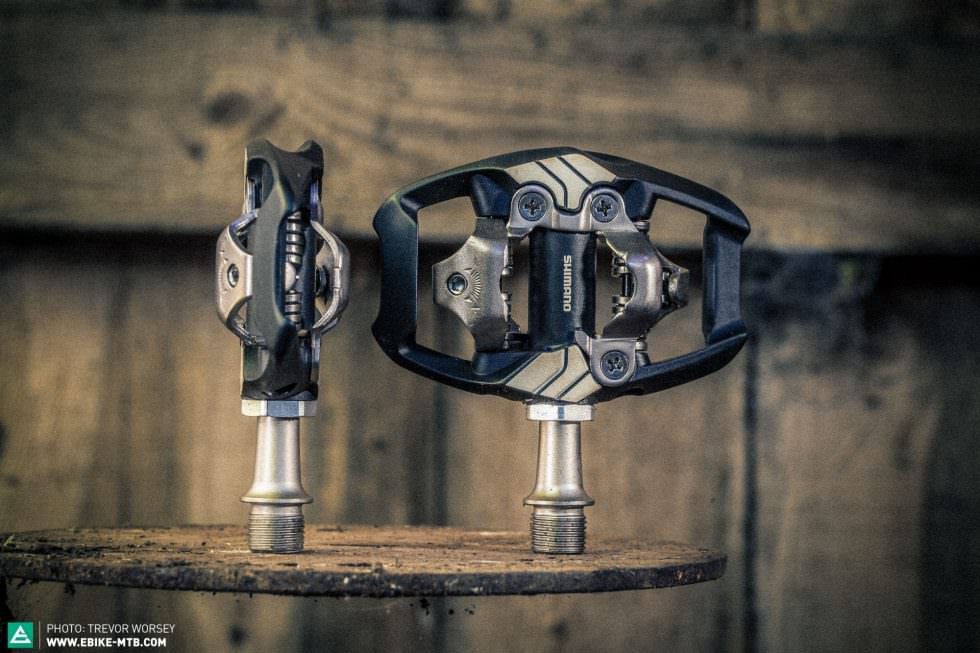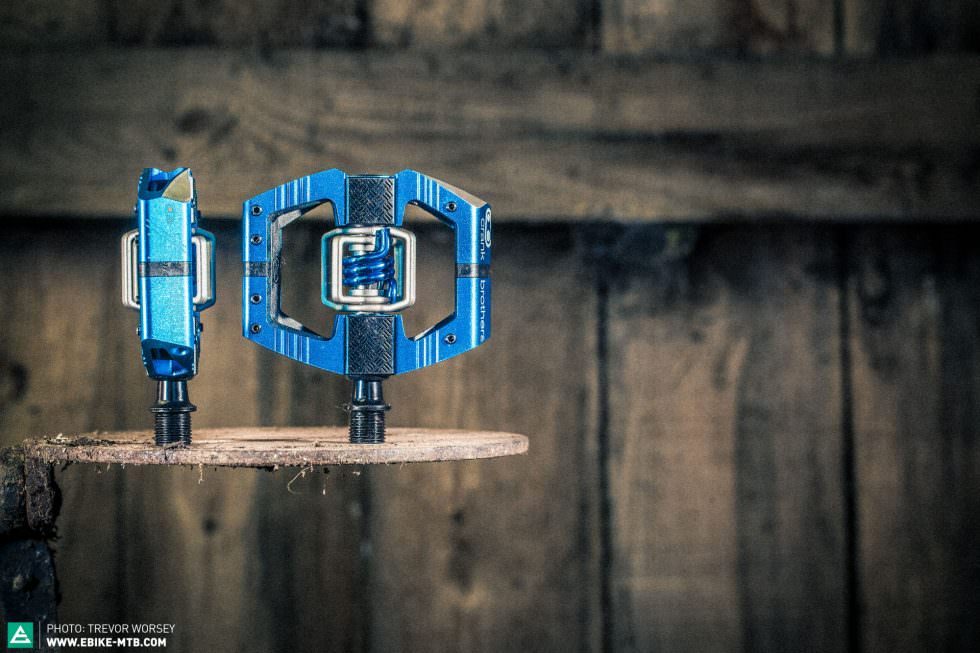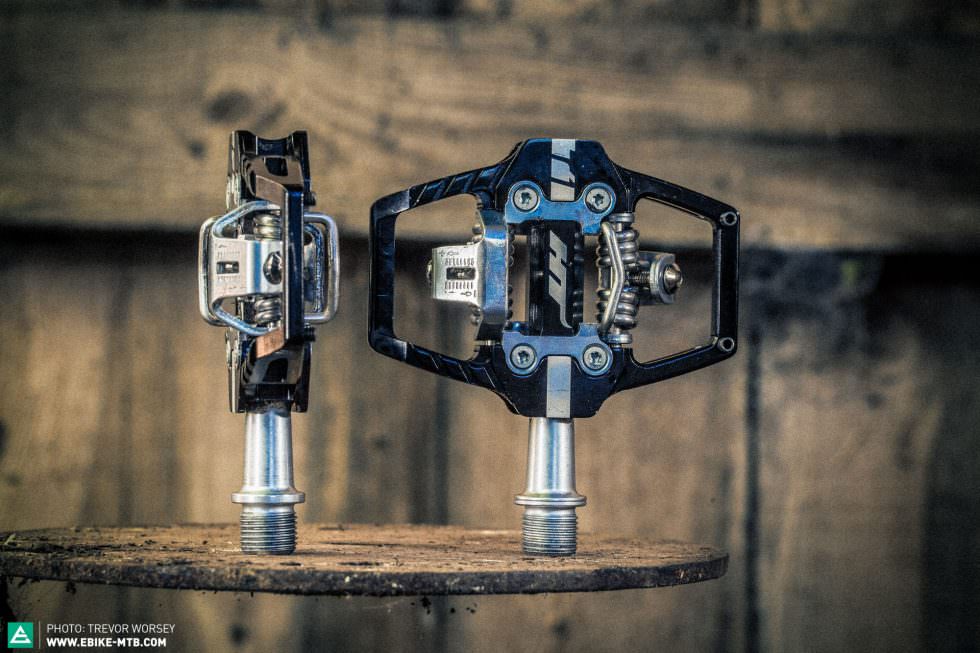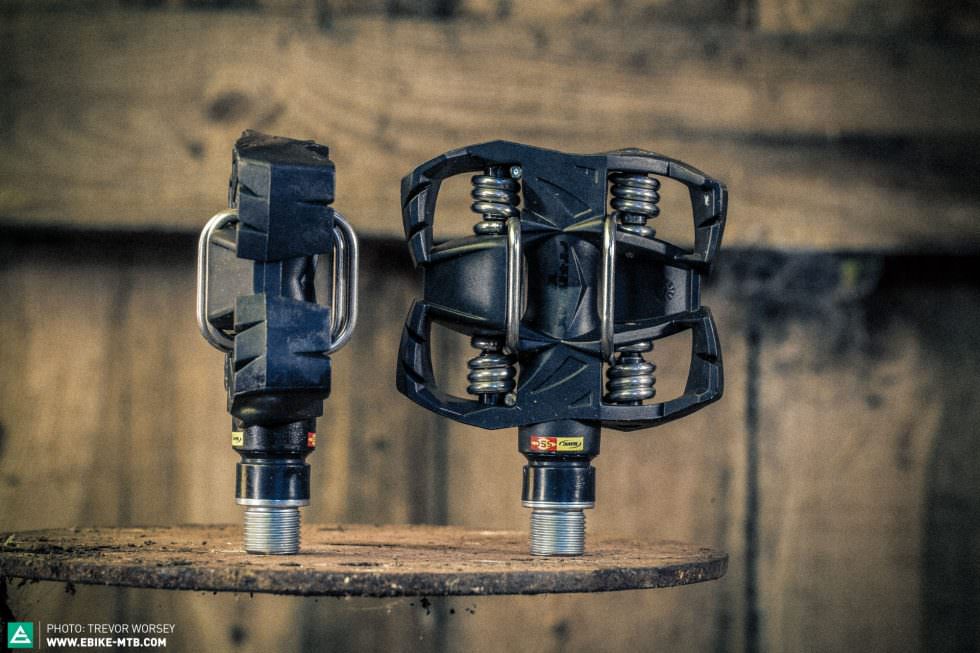When it comes to upgrading, it’s easy to concentrate on the sexy components: a new carbon handlebar, brakes powerful enough to peel the skin from the earth, or suspension units so sophisticated they make an F1 car look like the village idiot. But let’s not forget about the importance of good pedals! We reviewed the most popular clipless pedals to find the best one for you.
The pedal is a fundamental connection between you and the bike – it defines the way you ride and how your bike interacts with the trail. Every berm, compression, jump, and corner is controlled through your interaction with the grips and pedals (or less if you are getting really loose). If your feet are blowing off in all directions at the merest sniff of rough terrain, or your knees feel like they belong to a seventy year old, it’s time to look at your pedal choice.
You are not sure whether you should ride clipless or flat pedals? Or you want to know more about our test criteria? Then head to the main article: Flats vs. Clipless: E-MTB Pedal Group Test and check out our Flat Pedal Group Test
Overview
| Model | Price | Weight | Float | Engagement Positivity | Ease of Release | Resistance to Mud |
|---|---|---|---|---|---|---|
| Shimano XT PD-M8020+ | €135 | 407 g | 4° | ★★★★★ | ★★☆☆☆ | ★★☆☆☆ |
| Crankbrothers Mallet E | €165 | 427 g | 6° | ★★★☆☆ | ★★★★★ | ★★★★★ |
| HT T1 Enduro | €135 | 370 g | 4° | ★★★★☆ | ★★☆☆☆ | ★★☆☆☆ |
| Mavic Crossmax XL | €160 | 373 g | 5° | ★★★★☆ | ★★★★☆ | ★★★★☆ |
The Shimano XT PD-M8020 – €135

It’s fair to say that as Shimano invented SPD, they should know a thing or two about making a good connection between the rider and the bike. Arguably one of the most popular pedals on the market, the XT groupset has always represented the ‘real’ rider, the one who braves any weather and values desirability and durability in equal measure. It’s great to see that Shimano are now investing time on styling too, and the new graphics and smoother lines look mighty fine. The changes are more than skin deep though, and the new pedals now features a 3.3mm wider body than the outgoing pedal, with an 11.7% increase in shoe/pedal contact. These are unlikely to be numbers that will have a dramatic effect on the trail, but the outgoing pedal was excellent so improvements can only be a good thing.
At 407g, the pedals are a little heavier than some of the (albeit more expensive) competition, but the XT has always been one of the most reliable of the Shimano lines, and the forged alloy bodies have always been bombproof. The pedals feature two-sided entry and 4 degrees of float (with the supplied SH51 cleats), and the release tension is adjustable with a 3mm allen key. We don’t like that there is no indicator to show you the current tension; even though the adjusters are effective, you cannot visually check how tight they are. This is not a big problem, but others do it better. The pedals run on sealed cartridge bearings, and the body is open to help clear mud and debris from under the shoe – though it provides little support when your foot is unclipped.
The Shimano XT’s engage with a machine gun-like metallic ‘chang,’ letting everyone know that you are clipped in, and we found them very similar to the HT1’s with a firm and positive connection. When you’re pushing hard, the pedals have a more locked-in feeling than the others here, allowing you to put the power down with confidence. The trade-off is that they feel a little stiff and don’t permit much heel movement. Beginners may find this positive connection helpful, as it’s very clear when you are clipped in properly. We found initial engagement easy, but mud did clog the cleat, and they were the most difficult to engage in the mud – but a few swift whacks typically solved the problem. The XT’s are perfect for riders looking for a firm and secure connection to the bike, but those looking for more float should look elsewhere. In testament to the XT’s build quality, many riders have opted to use the XT, favouring them over the more expensive but apparently less reliable XTR model. For those on a budget, the M530 Deore versions are a little heavier and use lower quality bearings, but offer similar performance at a bargain-basement price.
Tops:
+ Very positive engagement
+ Sexy and affordable
Flops:
– Hard to engage in mud
– Limited unclipped support
For more information visit the Shimano-Website.
Crankbrothers Mallet E – €165

When it comes to the battle for clipless pedal dominance, there have always been two superpowers: Shimano and CrankBrothers. Since the introduction of the Eggbeater, CrankBrothers’ twin spring-loaded bar retention system has been the connoisseur’s choice when it comes to mud. Offering four entry points, they provide twice as many chances to engage and clear mud quickly. The spring tension is fixed, but the cleats can be switched from side to side to alternate between a 15 to a 20 degree release angle. When it comes to reliability, historically CrankBrothers have been known to have a somewhat demanding nature with poor bearing life, but is all that about to change? CrankBrothers want to set a new standard in durability, and the internals of the Mallet E’s have been completely reworked. The pedals now run on an inner IGUS LL glide bushings and outer Enduro cartridge bearing, with a reworked double seal to keep the grime out. The Mallet E’s are new to the market (we have only completed around 400 km on the test set), so it’s too early to report on longevity, but so far they have been a joy.
In use, CrankBrothers have a very distinctive feel. Compared to the firm ‘locked-in’ feeling of the Shimanos, the Mallet E’s allow a lot more unrestricted heel movement (float) on the pedal. With the 6 degree float cleats (a O degree cleat is available too), the foot is free to adjust smoothly. Clipping in is very easy, which will suit beginners or shredders who like to get their foot out in the turns. You can also clip in from a reverse direction should you find yourself dancing on the pedals through the rocks. Riders who like to move around on the pedal through corners will love the freedom, but those who enjoy a firm connection will find the feeling a little strange initially, and we experienced a couple of unplanned releases when riding hard. When the going gets grimy, the open body and rotating bars meant that mud has nowhere to hide. The beauty of the large body is that if you are getting wild and find yourself unclipped, the Mallet E’s will offer excellent support. The concave platform, textured surface, and six traction pins give your foot something to grip onto while you sort everything out. The pedal body also features chamfered edges to help lift the pedal over rock strikes should your aim be off. One thing we really liked was the new adjustable traction pads which can be swapped to allow you to customise the pedal’s body height and adjust the feel of the pedal under the foot.
The new Mallet E’s will please CrankBrothers fans, as they are 12% smaller than the very popular Mallet DH and weigh 427g – perfect for aggressive trail use. Retailing for €165, you would hope to get plenty of use out of them, so it’s great to see CrankBrothers are offering a five-year warranty on the pedals. They are available in any colour you like, as long as it’s black or electric blue. We were very impressed with the Mallet E’s and if they prove durable, they will be a winner for riders who love more freedom.
Tops:
+ Excellent float for dynamic riders
+ Class-leading mud performance
Flops:
– Very expensive
– No tension adjustment
For more information visit the CrankBrothers-Website.
HT T1 ENDURO Race – €135

When a pedal is called the H1 T1 ENDURO Race, it’s easy to write it off as a bold marketing claim – but when you discover that these are the pedals that have taken Jerome Clementz to a number of EWS victories, then they deserve respect. Weighing in at 370g in the chromoly version tested, they look like the bastard child resulting from a late-night encounter between a Shimano XT and CrankBrothers Mallet, mixing both bar and plate retention systems.
The pedals feature a 3mm front and rear tension adjuster which must be evenly balanced to provide consistent release tension. We like that the level is clearly displayed on an indicator for simple setup. Two different types of cleat give you the choice of either 4° (as tested with the X1 cleat) or 8° (with the X1F cleat) of float on the pedal. You can also run Shimano cleats with these pedals if required. We found that the tension adjuster had a marked impact on release forces and was easy to adjust to rider preference. The extruded aluminium body is CNC-milled with an open design to help mud shedding, and we like the utilitarian styling. We also liked the addition of the twin toe pins. The pedals run on Evo needle bearings and a DU bushing, and ran smoothly throughout the testing.
In use, the pedals have a unique feel in their action, as clipping in results is a very positive metallic “chung” and they feel very secure when engaged. The advertised 4 degrees of float is not smooth and floaty like a Crank Brothers pedal, and there is a slight resistance throughout the movement range. Release requires a firm twist to disengage, but it’s very intuitive. The H1 would be perfect for those who like a positive connection between rider and bike – great for putting down maximum horsepower through the pedals and aggressive riding. We found them perfect for racing, and despite our best efforts to initiate an unplanned release, they held on securely. We found that even though mud did not accumulate in the pedal body, it did tend to block the cleats, making engagement a little tricky in poor conditions. We were disappointed to find that the supplied toe pins did not really improve grip while not clipped in (which was not helped by the high mechanism), and engagement required a little more accuracy than some. The H1’s are best for advanced clipless pedal users and racers who want to maximise power and efficiency.
Tops:
+ Extremely positive connection
+ Perfect for aggressive riding
Flops:
– Cleats blocked easily with mud
– Positive connection means less float
For more information visit the HT-Website.
Mavic Crossmax XL – €160

The French know fair bit about enduro, and when Mavic decided to take on the might of CrankBrothers and Shimano in the clipless pedal arena, rather than go it alone they chose a powerful partner – Time. Mavic have rebranded Time’s legendary ATAC pedal to produce their own line, from the affordable €75 Crossride XL to the super-pimp titanium-axled €290 Crossmax XL Pro Ti. The €160 Crossmax XL’s utilise the ATAC’s simple, stainless steel spring-loaded bars; the tension isn’t adjustable, but you can reverse the cleats to achieve either 13 or 17 degrees of movement before disengagement, with a very smooth 5 degrees of float.
We were impressed with the Crossmax XL’s on the trail. The carbon-reinforced nylon body features ramps to guide the shoe to the correct engagement point, and we found clipping and unclipping intuitively easy, even in crazy terrain. Even thick mud did little to upset the pedals’ confident performance. Where the Crossmax XL’s excelled was in dynamic riding where the transition between being clipped in and released is easy to detect with a building of pressure. This predictable feeling made the pedals a testers’ favourite for jumps and-super aggressive turns, especially as lightning-fast dabs were still possible for those ‘foot out, flat out’ moments. If you ride them unclipped, the body doesn’t give you as much support as the Crankbrothers Mallet E, but there is enough support to stay in control.
Weighing just 373g with a chromoly axle and sealed bearings, the Crossmax XL’s won’t win any weight contests, but they are no heavyweights either. We have to admit having misgivings about the durability of the carbon-reinforced nylon body – how would they last under some serious abuse? Well, after 3000 km of testing and a season of EWS races under our belts, the bodies do indeed look absolutely hammered – but more importantly, they are still in one piece and function perfectly. Despite being abused in a jetwash, the bearings still spin smoothly and we have experienced no problems with any lateral play developing.
The Mavic Crossmax XL’s became the most popular pedal with our testers, as we loved the ease of entry and refined balance that created a secure connection with enough movement for dynamic riding, whatever the conditions. They are expensive, but after a demonstrating their durability they were an easy choice for our Best in Test.
Tops:
+ Superb for aggressive riding
+ Work well in all conditions
Flops:
– Nylon body looks tired quickly
– Expensive
For more information visit the Mavic-Website.
Conclusion
If you are looking for secure footing when unclipped, and if you like freedom of foot movement during hard turns, you will love the CrankBrothers Mallet E. This new pedal offers great support and performance, but longer-term testing is needed to reveal if the durability can impress too. In contrast, the lightweight HT T1 is a pedal that aggressive riders who favour a locked-in feeling will love. They provide a very firm and positive connection to the bike – but at the cost of ease of engagement. The Shimano XT M8020 brings a dose of style to the legendary pedal, and along with some minor tweaks to the platform size it will be sure to retain its huge global popularity. In the end there can be only one winner, and in this case it’s the Mavic Crossmax XL that takes the Best In Test. Working with Time, Mavic have produced a pedal that has exceptional engagement, feel, and function in all conditions. The top four pedals are all great performers, but come at a premium; for those looking for a cheaper option we highly recommend Shimano’s excellent M530 Deore (not featured) for Best Value, as it delivers great performance at a bargain price.
You are not sure whether you should ride clipless or flat pedals? Or you want to know more about our test criteria? Then head to the main article: Flats vs. Clipless: E-MTB Pedal Group Test and check out our Flat Pedal Group Test
Did you enjoy this article? If so, we would be stoked if you decide to support us with a monthly contribution. By becoming a supporter of E-MOUNTAINBIKE, you will help secure a sustainable future for high-quality cycling journalism. Click here to learn more.
Words & Photos:









